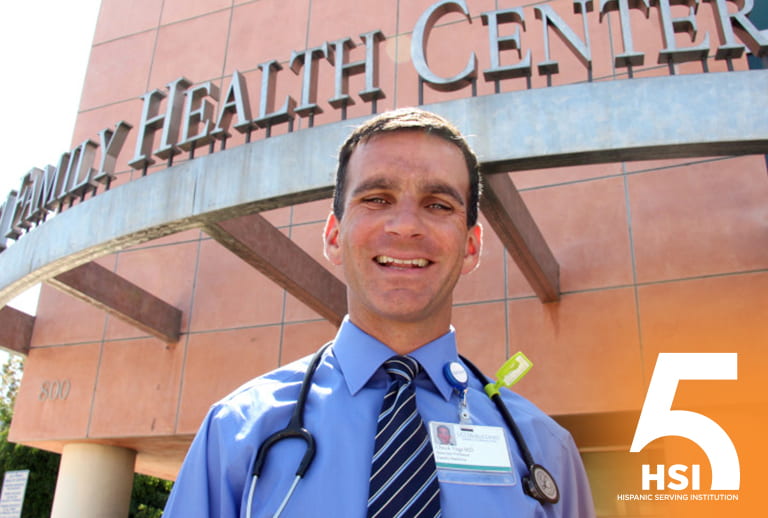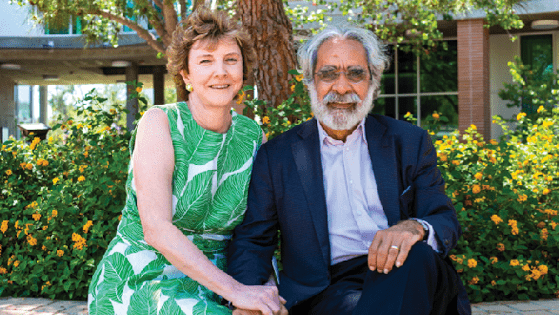Falling Leaves Foundation $30 million lead gift to fund innovative UCI medical research building
Facility to be designed to advance cross-disciplinary teaching, translational research activities

Irvine, Calif., Sept. 20, 2021 — Supported by a $30 million lead gift from the Falling Leaves Foundation, a planned state-of-the-art medical research facility at the University of California, Irvine will expand the global reach and impact of the campus’s advanced cross-disciplinary teaching and translational research achievements.
The approximately 200,000 square-foot Falling Leaves Foundation Medical Innovation Building will be one of the largest in the West and will provide optimal space for core instruction and laboratories to extend advances in medicine and the health sciences. The Falling Leaves Foundation was established by Prof. Robert A. Mah and Dr. Adeline Yen Mah in 2007.
“This exceptional gift recognizes UCI’s preeminence in conducting basic, translational and clinical research dedicated to the discovery of new medical and scientific knowledge,” said Chancellor Howard Gillman. “The Falling Leaves Foundation Medical Innovation Building will be a vital resource for exploring new frontiers and improving the lives of people in our community and beyond.”

The building will be set in UCI’s health sciences district along Michael Drake Drive, and it will include state-of-the art, well-equipped wet laboratories and meeting spaces to foster groundbreaking research and the training of future investigative pioneers. Teams from diverse disciplines will strategically collaborate to drive innovations that bring novel insights and new treatments to help communities thrive.
“This gift is inspirational and visionary. The research which will be done in this building will help shape the future of health and wellness,” said Steve A.N. Goldstein, M.D., Ph.D., FAAP, UCI vice chancellor for health affairs. “The Drs. Mah have led remarkable lives of innovation including teaching and research in microbiology and in clinical care and have left lasting impact in their fields. Two species of archaebacteria, Methanohalophilus mahii and Haloterrigena mahii, as well as the genus, Mahella australiensis, were named in honor of Dr. Robert Mah for his research on the anaerobic archaebacteria.”
Goldstein added: “Innovation is the backbone of our mission: Discover. Teach. Heal. It underpins the design of the new building, which will house programs that capitalize on work that crosses disciplinary boundaries and fosters collaborations not only with our healthcare system, UCI Health, but throughout the university and with industry to speed discoveries to our patients.”
The cutting-edge space will enable UCI to recruit and retain high-profile faculty and launch promising careers for basic, translational and clinically trained scientists. It will allow students to learn alongside these researchers and physician-scientists on floors dedicated to specific health issues, including cancer, neuroscience and drug discovery. Findings revealed in these laboratories will be transformed into more effective tools to predict and prevent illness and treat disease, elevating healthcare in Orange County and around the world.
Fulfilling a dream

While Robert Mah, a professor emeritus at UCLA, taught environmental microbiology and Dr. Adeline Mah practiced internal medicine and anesthesiology during their professional careers, it was their dream to do medical research together. In UCI, they found the ideal partner to transform their vision into creative realities.
“The future of medicine,” Adeline Mah said, “is being advanced at an unbelievable rate. 21st century medical innovation is a collaborative process derived from brilliant minds working together rather than flashes of insight from solitary scientists working alone in his or her lab.”
“Medicine is at the threshold of a new era,” she added. “RNA therapeutics has a virtually limitless future. All of us are witnessing the efficacy and safety of mRNA vaccines developed by Pfizer and Moderna. This is only one example. Eventually, every disease will be treatable. We are at the dawn of a therapeutic revolution.”
“Successful collaboration is helped greatly by physical proximity,” she said. “We were impressed by the many sprawling, open workspaces in UCI’s Innovation Building, where scientists will interact with one another and exchange ideas. It gives us enormous satisfaction to imagine the possibility of brilliant young minds working together and bringing concepts to fruition, some as a result of serendipitous encounters in the building’s atrium, coffee shops and numerous scattered seating areas.”
The Falling Leaves Foundation Medical Innovation Building will join the new Susan & Henry Samueli College of Health Sciences and Sue & Bill Gross School of Nursing and Health Sciences Hall in the growing Health Sciences district, which is only a mile away from the planned UCI Medical Center-Irvine now starting construction. Several established research facilities are also located in the district, including the Biomedical Research Center, which houses UCI institutes and centers where groundbreaking work is conducted in neurosciences, stem cell biology, genomics and proteomics, precision health, AI and data science, and infectious diseases.
“This generous lead gift is the realization of a dream to create a destination that empowers our distinguished researchers today and educates the leaders of tomorrow,” said Brian Hervey, vice chancellor of University Advancement, who will lead the charge to raise an additional $20 million for the project. “Our hope is that this transformational gift will act as a catalyst that will inspire others to contribute to a legacy of innovation that is unique to UCI.”
About the University of California, Irvine: Founded in 1965, UCI is the youngest member of the prestigious Association of American Universities and is ranked among the nation’s top 10 public universities by U.S. News & World Report. The campus has produced three Nobel laureates and is known for its academic achievement, premier research, innovation and anteater mascot. Led by Chancellor Howard Gillman, UCI has more than 36,000 students and offers 224 degree programs. It’s located in one of the world’s safest and most economically vibrant communities and is Orange County’s second-largest employer, contributing $7 billion annually to the local economy and $8 billion statewide. For more on UCI, visit www.uci.edu.
About the Falling Leaves Foundation: The Falling Leaves Foundation was established in 2007 by Professor Robert A. Mah and Dr. Adeline Yen Mah. Its mission is to promote research and understanding of recent advances in medical science. Medicine is at the threshold of a new era because of a better basic understanding of RNA functions and its applications in technology. RNA plays a key role in nearly every biological pathway. Coupled with genome editing tools such as Crispr, every disease will be treatable. Falling Leaves Foundation will contribute towards the fundamental conceptual understanding of these processes and to the applied research and development of this type of innovative technology.
About UCI’s Brilliant Future campaign: Publicly launched on Oct. 4, 2019, the Brilliant Future campaign aims to raise awareness and support for UCI. By engaging 75,000 alumni and garnering $2 billion in philanthropic investment, UCI seeks to reach new heights of excellence in student success, health and wellness, research and more. Learn more by visiting brilliantfuture.uci.edu.
Media access: Radio programs/stations may, for a fee, use an on-campus ISDN line to interview UCI faculty and experts, subject to availability and university approval. For more UCI news, visit wp.communications.uci.edu. Additional resources for journalists may be found at communications.uci.edu/for-journalists


